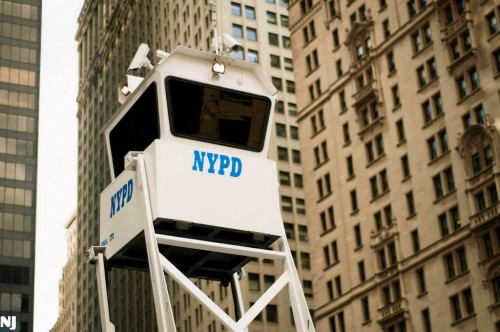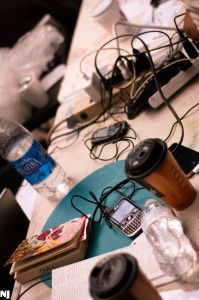
The first post I wrote for Cyborgology concluded that many of the dominant socio-technical systems in our world look and behave in a similar fashion. The entertainment industry, advanced military surveillance, search algorithms, and academic reference tools are swapping hardware and best practice in such a way that the carrying out of a military invasion, or the Super Bowl begins to look disturbingly similar. Around the time that I wrote that post, USAToday ran a disturbingly cheerful story about police departments’ desire to acquire similar technology. Miami’s police department acquired the Honeywell’s T-Hawk Micro Air Vehicle (MAV) a few moths later. The only regulations that prevented the MPD (or any police force) from acquiring such technology were FAA regulations about where and how it could be flown. Such acquisitions have gone largely unquestioned by the media as well. In fact, local coverage of the purchase was supportive. A local CBS affiliate led with the headline, “Dade Cops Waiting To Get Crime Fighting Drone Airborne.” This all seems very bleak, but just as powerful actors have increased their abilities to engage in surveillance, the individual has more tools than ever to watch the watchers.
At Zuccotti park, there is a literal panopticon sitting at the northwest corner. The mobile surveillance tower stands about a story tall on thin white struts. The tower has several panes of blacked-out glass, which makes it impossible to tell who or what is sitting in it and when.

We have come to expect being watched, and through that expectation we alter our actions accordingly. These systems allow the powerful to watch (and through doing, alter) both our public actions and our private thoughts. But there is another system that stands to push back on our surveillance culture. By taking up a video camera or some other sensing device, participants engaged in political actions can redefine the social pressures that are being enforced in that moment. As Kate Shilton noted in Surveillance and Society:
“…participatory sensing has the potential to do more than simply help individuals comply with consensual social norms. Its focus on participation in defining data collection and understanding the meaning of sorting and analysis could enable individuals to identify that they are in fact the subject of such social pressures.”
Recall back in September, some of the first videos to go viral from Occupy Wall Street was the indiscriminate macing of protestors by Officer Anthony Bologna. Once that video became popular, NYPD spokesman Paul J. Browne implied that the video had been selectively edited. Since more than one camera was rolling at the time, protesters were able to show many other perspectives and angles of the same incident. In the same way scientists replicate experiments to validate their conclusions, multiple camera operators are able to refute allegations of tampering and editorializing. These multiple perspectives are one of the key strengths of sousveillance. Whereas surveillance is the watching of the many by the few from above, sousveillance is the watching of the few by the many from below.
The ubiquity of individually owned recording devices (usually cell phones, but also cheap video recorders and digital cameras) coupled with the multitude of accessible mass distribution platforms is a powerful tool against police brutality and other kinds of abuses. While it is not nearly as powerful or robust as the socio-technical systems I described in “Panopticon in the Clouds” the “Panopticon in the Crowds” is gaining strength.
The Clouds have a superior advantage for a three reasons. 1) The crowds rely on the clouds. The participatory sensing that makes sousveillance possible relies on the same infrastructure used for surveillance. Most of our social networking happens on private services owned by big companies. Those bits travel through hardware owned by more big companies. If any large entity wanted to put a stop to occupation footage, they could (although it would not be easy.) 2) Reacting to images seen through surveillance is easier than those captured by sousveillance. The relationships between the watcher and authority are clearer and the action is more directed. A guard sees the glimmer of a knife in the hand of a prisoner, and a straightforward, predetermined, course of action takes place. When a crowd sees police brutality, cameras come out, actions are recorded and broadcast, but the response is undetermined and a reaction is not guaranteed. Activists can call for firings or criminal allegations, but they do not have the institutional authority of prison guards. 3) Surveillance has more access to capital. While surveillance systems are backed by powerful institutions like the NYPD and JP Morgan Chase, sousveillance systems must rely on sheer numbers of participants (and their ability to acquire technology and skills) to be effective. Surveillance systems are tailored to specific needs, and are implemented by well-funded institutions. Sousveillance is achieved through the appropriation of existing technology that is not meant for that express purpose.
Using the term “empowering surveillance” instead of what I am calling “sousveillance” Shilton concludes,
Participatory sensing will coexist with broad data surveillance by corporations and governments, and may also be used towards pernicious ends. But, with its emphasis on participation and targeted collection, participatory sensing may simultaneously give people their own way to use tools and platforms of surveillance. Participatory sensing, when developed with a focus on local control, participation, transparency, and social justice, emphasizes learning, messiness, and experimentation rather than rigid categories and conformity. This is why empowering surveillance is not just possible, but desirable.
Perhaps we will look back on this historical moment and characterize it as a time of “watching wars” where large actors created more and more sophisticated monitoring systems as individuals wielded their own cameras in an attempt to document their own side of the story. The perfecting of surveillance systems during the rise of sousveillance guarantees that no matter what the outcome, it will be -if nothing else- well documented.
Follow David Banks on Twitter: @da_banks

Comments 9
PJ Patella-Rey — November 9, 2011
Great piece David. I especially like the word play used to differentiate surveillance ("panopticon in the clouds") and sousveillance ("panopticon in the crowds")--clever, but at the same time accessible.
One more wrinkle: There are some interesting issues surrounding the legality of sousveillance. Court cases are underway where individuals are tried under wiretapping legislation for recording the police with their smartphones. I talked about it briefly here: http://thesocietypages.org/cyborgology/2011/06/16/do-americans-have-the-right-to-conduct-citizen-surveillance/
Nathan — November 10, 2011
Although I'll concede that mobile surveillance tower's like the NYPD's have the ability to create the circumstances of panoptic control, I think the usage of one at Zuccotti Park does not for several reasons. Mainly, Zuccotti Park is bounded by streets on all four sides, and the police presence is situated similarly. This is not a case of the police conducting surveillance from a central position outwards. Rather, it is surveillance from the periphery looking in. I think this is a major distinction. It might be easy to label any mode of surveillance as having panopticon-like attributes, but the fact remains that the control that the NYPD is trying to exert over the protesters is not through internalized discipline, but rather by physical force.
David Banks — November 21, 2011
Here's a great example of Sousveillance in action:
http://www.zdnet.com/blog/igeneration/uc-davis-official-spin-crumbles-in-the-face-of-too-many-videos/13347?tag=mantle_skin;content
Replqwtil — December 11, 2011
Love the post! I think this is a really important phenomena to be watching. I just wanted to note that Sousveillance does not necessarily need to be deployed "by the many against the few" in terms of a mass watching elites, it is equally used by the mass to watch itself / each other, like the in the case of the Vancouver Riots. It falls into an interesting state of self-surveillance by a group.
We Have Never Been Actor Network Theorists » Cyborgology — December 21, 2011
[...] systems in the developing world, augmented warfare, and the changing landscape of surveillance and sousveillance have also been motivated by topics that ANT shows little interest [...]
Self-Organization and The Hierarchy of Institutions » Cyborgology — December 31, 2011
[...] news, while a third system might mount aerial drone attacks in the mountains of Pakistan or monitor the actions of Occupy Wall Street. While these systems are not identical, they do share some very specific commonalities. They are [...]
Augmented Activism: A Tactical Survey (Part 1) » Cyborgology — February 12, 2012
[...] have written on the power of sousveillance in the past, but must agree that there are limitations to its efficacy in the national context. [...]
Surveillance and Sousveillance | BoyDownTheLane — November 24, 2013
[…] Sousveillance and Justice: A Panopticon in the Crowds […]
Improving the Wearable » Cyborgology — June 22, 2014
[…] wearables should promise to never sell their devices to governments or law enforcement. Call this a pet peeve of mine, but when policing authorities gain access to new kinds of cameras, it gets increasingly […]